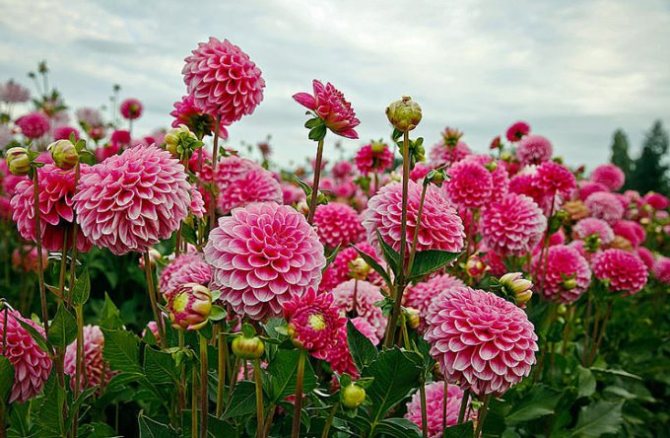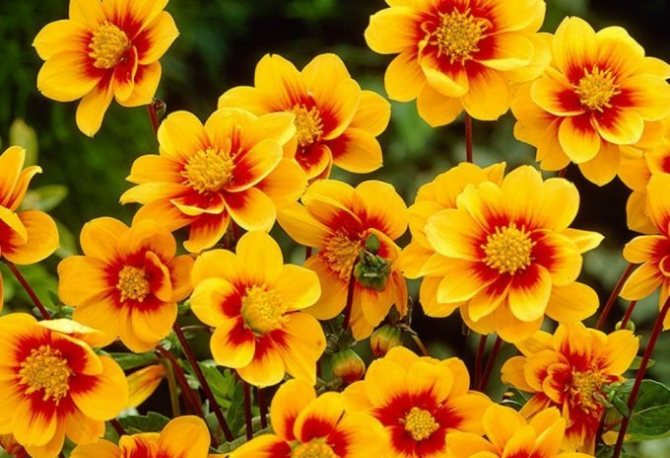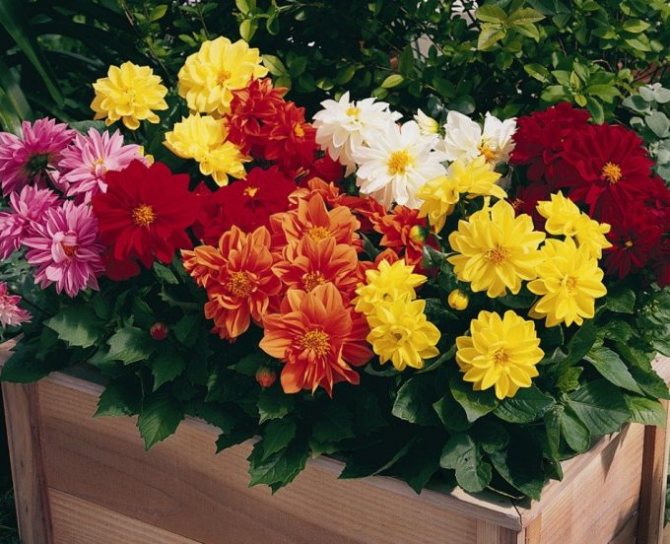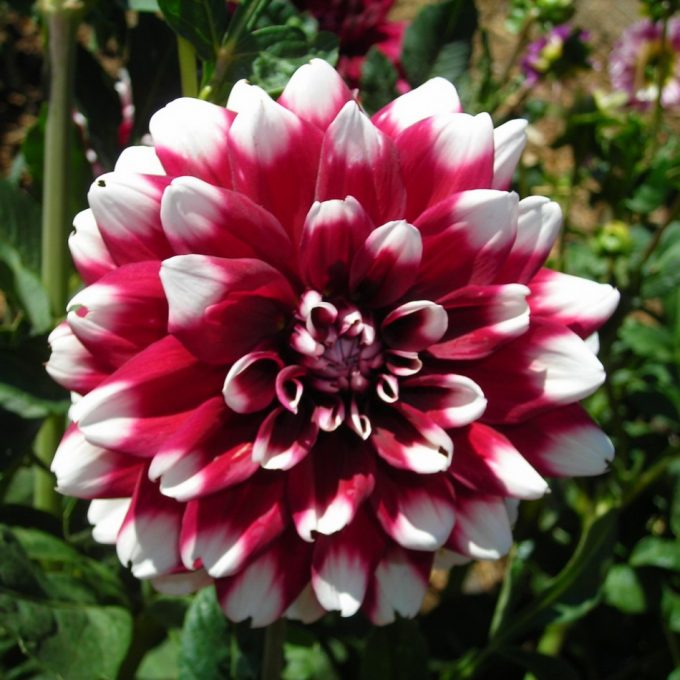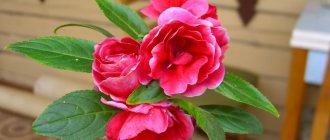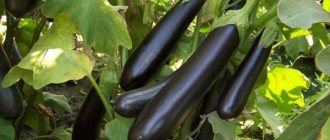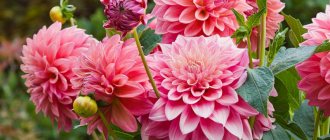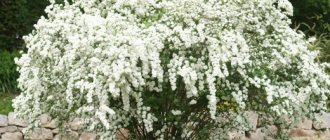Dahlia (Dahlia) belongs to the Astrov family, came to us from Chile, her genus is numerous and diverse. But, despite this, natural species in cultural floriculture are practically not used - they are bred exclusively by collectors and originals. This is not surprising, because varietal dahlias are many times superior in their decorative qualities. Now there are more than 15,000 varieties, and their number is growing every season.
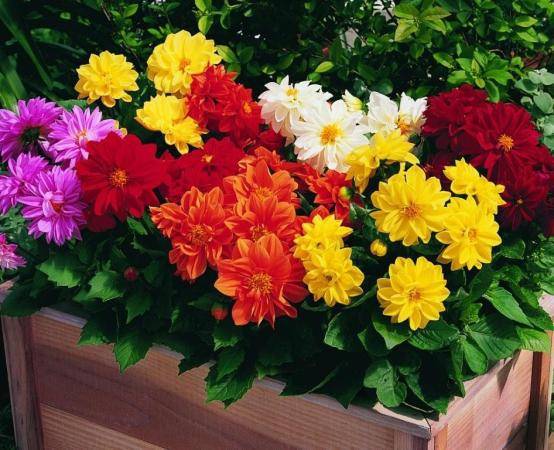
These flowers are remarkable for their diversity: the tallest varieties exceed one and a half meters in height, while the undersized ones may not reach 30 cm, the size of the inflorescence is from 3 to 25 cm and more. Dahlia flowers can be simple, double, semi-double, with open or turned outward petals, there are even "collar" inflorescences. Nature did not skimp on color - it can be snow-white, all shades of yellow, orange, pink, purple, red, there are varieties of almost black color. Very often, dahlias are painted in several harmoniously combined colors. Recently, low-growing dahlias have been very popular.
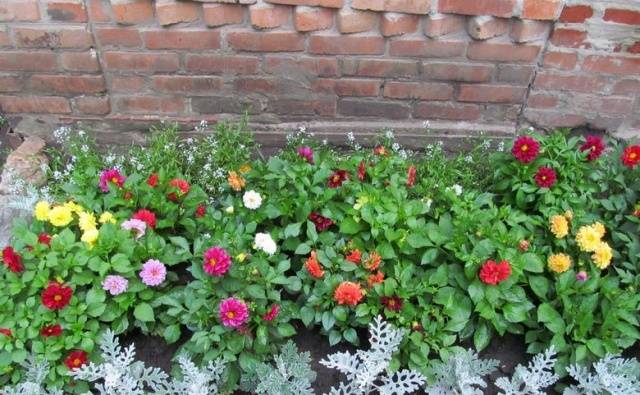

Description of low-growing dahlias
The popularity of dwarf dahlias came recently, after breeders were able to bring out beautiful miniature flowers. Such plants are resistant to unfavorable conditions of keeping, to diseases, they are excellent for growing in any containers.
Some growers call dahlias undersized curbs. Although this is a misnomer. According to the International classification, curb dahlias should be 60 cm high, and dwarf dahlias grow only up to 30 cm.
The height of dahlias directly depends on planting and growing conditions. One variety of flowers can reach up to 40-50 cm or its growth will not exceed 20 cm, it all depends on the circumstances. When growing flowers, you need to take into account the structure of the soil, its quality, the amount of fertilizing, watering, and the ecological situation. The better the conditions, the taller the plant will grow. And this does not affect flowering. With a large build-up of green mass, dahlia can bloom very poorly.
Application in design
Galleri dahlias are planted for edging curbs, flower beds with low-growing plants, on balconies and terraces. All plants from the series are graceful and decorative. No wonder that the author gave the majority of dahlias the names of famous artists who made society look at art in a new way. Flowers located in the foreground of buildings are especially expressive and picturesque. The monochrome walls emphasize the graphics of the leaves and the purity of the colors of the petals. Flowers are also suitable for indoor growing. In the cut, they stand for almost a week.
Dahlia structure
Dahlia is most often a perennial plant, although there are annuals as well. Every year, the aboveground parts of it die off, root tubers serve as the basis for the development of the plant. They are also a storehouse of nutrients. The plant includes:
- Root tubers that are thickened roots. They store a supply of nutrients and moisture. They are necessary so that the plant can survive the dormant period, and begin to actively develop in the new season.
- Root collar. This is the lower part of the stem, modified roots are attached to it.In autumn, digging up the roots, it is not recommended to cut the neck, new stems are later formed at its base. Root tubers whose root collar is completely cut off will not be able to give a new plant. They can only be thrown away.
- Stem. The stems of dahlias are hollow but strong. Low-growing flowers do not need to be tied to a support, unlike tall ones.
- Inflorescences. In dahlias, the inflorescences are a complex basket, painted with all kinds of flowers. Each basket consists of rolled petals and marginal reed flowers. They can be rolled out or in, flat, collared.
You may be interested in: Dahlias funny guys: description and photo of the flower
Flowers attract florists with their diversity, not only in shape, but also in color. In the gardens you can see all shades of orange, yellow, snow-white, red, purple, red. There are even flowers that combine several shades.
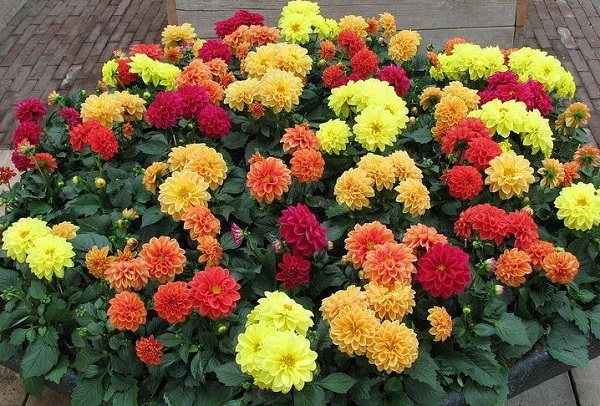

Breeding methods
The propagation methods for these flowers are standard. It is carried out by sowing seeds (discussed above), dividing tubers and grafting:
- When grafting on grown dahlias, young shoots 8–9 cm long are cut off. The cuttings are immersed in river sand and covered with foil. The first roots appear after 2 weeks. After such reproduction, future plants bloom in larger inflorescences.
- When dividing tubers, only strong and healthy specimens are selected. 2 weeks before planting in the ground, tubers after wintering are placed in plastic bags, tied tightly and moved to a warmer and brighter room. After a week, the bags are opened, the tubers are sprayed with water. They are planted in a week in soil warmed up to +10 degrees.
It is not difficult to grow Gallery dahlias in your area or at home. One has only to follow the basic rules of care, and you can enjoy the long flowering of colorful balls that will delight the eye for many months.
Dahlia life cycle
A new growing season begins in dahlias only when the previous one is completely completed. Even if you transplant a flower into a pot, transfer it to heat, water and feed, the plant will still die. It is necessary to cut off the stems as soon as the first frosts hit. Root tubers are dug up and taken to a dark storage place. At a temperature of about 7 degrees, they can rest for several months.
As soon as the root cones awaken, the growing season begins. They need to be brought into a warm room, moistened and exposed to light. Dahlias are planted in the ground when the weather is right. After frost, the root tubers are removed from the soil, the cycle begins anew.
Dahlia can be propagated by seeds or seedlings. The rest of the plant behaves in the same way as others. Seeds germinate, roots are formed, then root tubers are laid.
Cleaning and storage


Dahlias are dug for the winter, and the harvest time depends on the climatic conditions of the region. The main thing is that the tubers do not get frozen.
In the middle lane, they are usually dug in mid-September, in more northern regions, as well as in the Urals, in Siberia, they will have to be cleaned earlier - with the onset of autumn. The leaves and stems are carefully cut, the tubers are dug up.
ON A NOTE!
You cannot pull the tubers out of the soil by holding onto the stem. This damages the dahlias.
Then the nodules are dried and stored. The dahlias of the Gallery collection have small tubers, and this is also a serious advantage of the varieties. Not every summer resident can create good conditions for storing large tubers, but there are no problems with this variety series.


The optimum temperature for preserving the planting material of dahlias is + 3… + 5ºC. A dry basement, pantry will do. The nodules are placed in boxes, boxes, shifting them with sawdust, coarse river sand, peat.It is necessary to carry out regular inspections of dahlias, removing all damaged specimens in time.
ON A NOTE!
When drying the tubers, peat or sawdust is recommended to be slightly moistened with a spray bottle.
What if there is no basement, dry cellar or storage room? In urban settings, the tubers of the Galleri dahlia can be saved by placing them in bags with sawdust, peat on a glazed balcony. But here you should monitor the temperature, since in case of severe cold snaps, you will need to bring all the planting material home for a short time.
One of the common ways to preserve nodules in a city apartment is to cover them with paraffin.
- Paraffin must be melted in a water bath.
- Quickly dip the nodules of the flower into the melted mass.
- Wait a few seconds until a thin film forms.
- Re-dip the tuber in paraffin.
- Wait until it hardens on the tuber again.
After such a double "bath" in paraffin, the nodules are placed in a bag with sand or sawdust, tied tightly and stored.
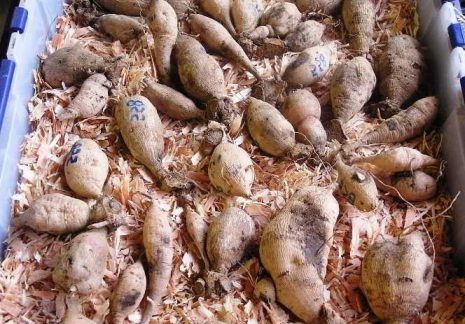

In the spring, they gently rub the paraffin film from the planting material with their hands and the tubers are ready for planting.
Gallery dahlias "wake up" early, and nodules with buds can be planted in special containers with soil already in April. These specimens will delight you with early flowering.
Dahlia varieties
In 1962, the International Classification was adopted, but the undersized varieties of Dahlia did not get there. At that time, flower growers were not at all interested in them. The popularity of dahlias began only after the introduction of the "Galeri" variety by Dutch breeders.
Variety "Galery"
Breeders have been working on the creation of the variety for 15 years. In 1994 they presented a collection of varieties of the most beautiful dahlias "Galeri". They are terry varieties that can be grown in containers and pots. They can be left in pots for winter storage, they do not take long. Tubers of these varieties tolerate waxing well and can be stored in the refrigerator.
The growth of the bushes is about 40 centimeters, but it depends on the growing conditions. To get compact plants, you need to water the plants moderately without adding too much fertilizer. The inflorescences of the variety are quite large - about 15 cm.
You may be interested in: Dahlias, planting and care in the open field, growing decorative flowers
The collection of this variety includes:
- Cobra is a variety with orange-colored reed flowers bent inward.
- Renoir - pink double flowers.
- La Tour is a beautiful variety with pink flowers, on the tips of which a purple tint is noticeable.
- Bellini is a double-flowered variety with bright pink flowers with a very light inside.
- Vincent is a variety with original orange flowers.
- Rembrandt is a variety with pale pink flowers.
- Vermeer is a golden variety, large flowers with pointed petals.
- Art Fire is a snow-white variety with a yellowish center.
- Serenade is a variety with yellow inflorescences, with wavy petals.
- Art Nouveau - pink flowers, marginal petals slightly curved to one side.
- Pablo is a variety with yellow petals with a salmon pink blurred edge.
- Cezan - white flowers.
- Art Deco - bright red dahlias.
- Sisley is a pink-lilac variety.
- Singer is a classic red variety.
- Salvador is a rose petal variety with dark touches.
- Coins are an original variety with white petals.
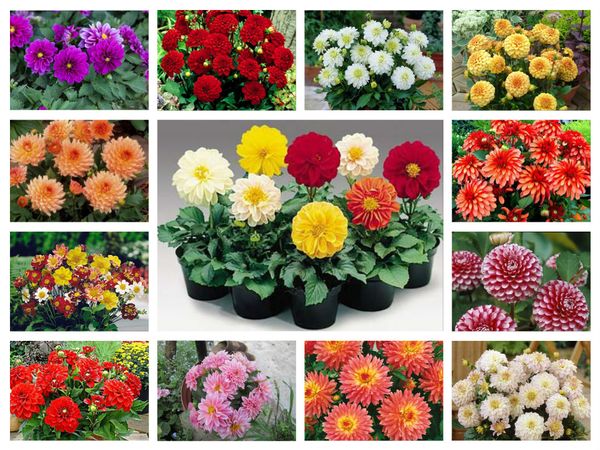

Dahlias "Mignon"
The term "minion" is a shorthand designation. It unites varieties that are propagated by seeds. The main advantage of these varieties is that the planting material does not need to be stored, dahlias grown through seedlings bloom very early, the buds are released until the very frost. They grow well in the open field, and no worse in pots.
This does not mean that tubers that form over the summer should be left in the ground.You can dig them up and germinate like a regular dahlia next spring. It should be noted that the flowers of the next season may lose their doubleness.
Variety "Funny guys"
This is the oldest variety of dahlias, its flowers can be simple or double, have a wide variety of colors. The variety is easily propagated by seeds.
Care
The varieties of this Dutch series do not require any special care, but the main activities must be carried out. The bushes do not need shaping, and Gallery's dahlias do not need support. This simplifies care, but does not affect the quality of the inflorescences at all.
Watering
Watering should be regular, while taking into account the type of soil, weather conditions, the condition of the plants themselves. In the heat, they water more often, on rainy days, watering is reduced.
The soil should be thoroughly soaked, but the moisture should be quickly absorbed and not stagnant. Otherwise, it can cause rotting of the tubers.
ON A NOTE!
It is convenient to water curb dahlias through special watering grooves. Then moisture will evenly flow to the tubers, while eliminating the risk of flooding the bushes.
Top dressing


For a lush and abundant flowering, dahlias need feeding. You should not abuse this, an excess of certain components only harms the plants.
If fertilizers were applied to the holes before planting the tubers, then the next top dressing is carried out about two weeks later. You can use organic matter, alternating it with complex fertilizers. As soon as the buds appear, they stop applying nitrogen fertilizers, feeding the dahlias with phosphorus and potassium components.
IMPORTANT!
All fertilizing is carried out only after watering or past rain.
It is effective to use special mineral compositions for flowering plants as fertilizers. All faded inflorescences are regularly removed from the bushes.
Preparing for landing
Dwarf dahlias love fertile, neutral soil. To prepare a place for planting, in the fall, the earth is mixed with heated sand, humus or peat is added in equal proportions. Before sowing, the soil is treated with a solution of potassium permanganate to disinfect and protect against diseases.
For dahlias, a spacious area is needed, since even dwarf varieties grow very quickly and densely. The distance between the bushes should remain large enough. It is better if the planting site is sunny and warm, closed from drafts. It is not recommended to plant these plants under any structures and trees, they need light, especially in the morning. Lack of light will immediately affect the quality of flowering. The stems will reach for the light, become fragile, thin. It has been noticed that dahlias grow excellently on the southern gentle slopes.
You may be interested in: How to dig dahlias for winter storage
How to care for flowers
Dwarf dahlias, like other types of garden plants, require regular feeding. For 10 liters of water, 15 g of fertilizers are taken (Kemira Universal works well) and the solution is poured under the root of the plant. This procedure is performed in June. Slurry is applied 2-3 times in the first 2 summer months. In early August, the bushes are fed with phosphorus-potassium supplements, which accelerates the ripening of the roots. Care also consists in constant loosening and weeding, carried out at least 4 times per season.
Planting dahlias with seeds
Dahlia seeds can be planted in open ground at the end of May. The threat of frost passes, you can no longer be afraid of temperature changes. The seeds are immersed in a 10% formalin aqueous solution for a few minutes. Then they are well dried and planted. This planting method is easy, does not require growing seedlings, but lush flowering will not occur until the end of August.
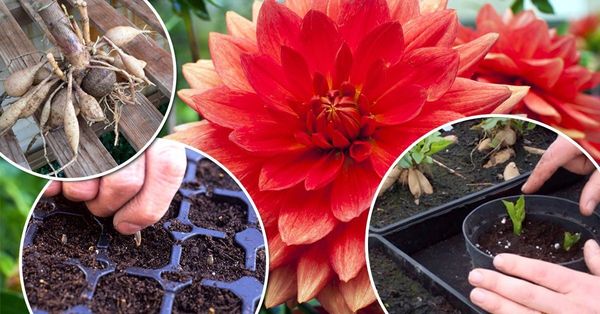

Growing seedlings
You can grow dahlias from seedlings. Seeds are sown at the end of March in wooden boxes or plastic containers.Cover with foil. The seeds of dwarf varieties are large, they are placed 3 cm apart from each other to a depth of 2 cm. Sprinkle on top with a mixture of soil with peat or a layer of clean sand, slightly compacted, watered with warm water. Seedlings should appear in ten days.
As soon as the seedlings grow and form two leaves each, you need to pick. Dahlias are seated in a separate container or in one container at a distance of 15 cm. Peat cups, paper bags will do. Watering during this period should be moderate. In May, the seedlings begin to be exposed to the air to prepare for planting.
Seedlings are planted in the ground at the end of May at a distance of 20 cm from each other. In the early days, you can cover the seedlings at night with geotextiles. A little ash, humus and nitrophosphate are added to each hole. It is advisable to mulch with sawdust.
History
Dahlias are a family of flowering plants with a long history. The first mentions of their cultivation date back to the times of the ancient peoples of the Maya and Aztecs. The Maya decorated their temples with them and used them in various rituals. And the Aztecs even found engineering applications for dahlias - they used hollow plant stems as water pipes; root vegetables were used by them for food.
In 1557, dahlias from Mexico reached Europe and immediately became in great demand. Scientific research on the plant began only in 1791 - Antonio José Cavanilles, director of the Royal Botanic Gardens in Madrid, became interested in him. The flower received its modern name in 1803, when it was named in honor of Johann Georg, professor of botany at the Academy of Sciences of St. Petersburg. Since then, the family has up to 15 thousand different species.

